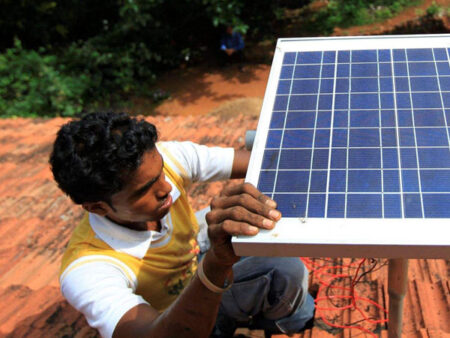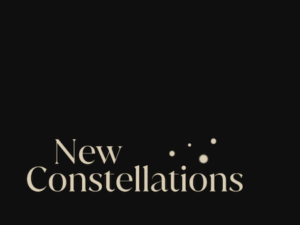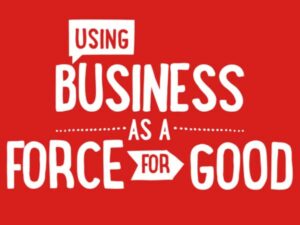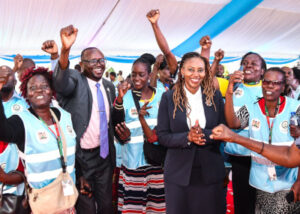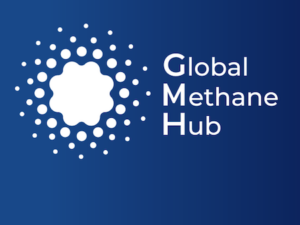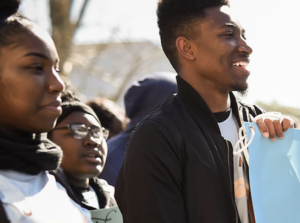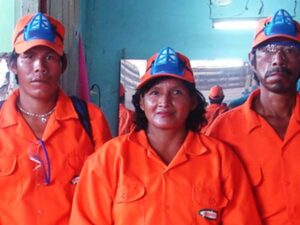SELCO Foundation is increasing access to sustainable energy in underdeveloped countries and communities by developing solutions that fit local contexts. Rather than getting people “on the grid,” the goal is to create climate-friendly solutions and support communities in leading the way on sustainable energy.
Rachita Misra of SELCO Foundation spoke with Priyanka Shankar on February 16, 2023. Click here to read the full conversation with insights highlighted.
Priyanka Shankar: Can you introduce yourself and tell me a little bit about the exact problem you are addressing through your work?
Rachita Misra: I’m Rachita Misra and I’m associate director with Selco Foundation. I’ve been with them for about eight years now. We’re an implementation based organization, so we do our own projects underground. Early on I spent more time actually implementing projects, so I have that grass rooted experience. In the past two or three years, I’ve been primarily looking at the knowledge portfolio of the organization. Really kind of curating and developing that, which doesn’t just include the monitoring and evaluation of our work, but I think more importantly, it also includes the research and studies that we do, which inform our strategy, inform our program direction, and inform our approach. That’s been very important to show how [our programs] are doing and whether our capacity is improving over time. In the development sector, narratives keep changing, problems keep changing, how problems get oriented on the ground keeps changing, because of political, cultural, and aspirational factors coming in.
A very important aspect is research on how to improve all of that, accommodate all of that in our decision making itself. That’s another part of the work. Selco Foundation uses sustainable energy as a means to development. For us it’s very important that we’re actually saying what the energy is used for. Not just saying you need energy, that’s the last thing that we want to do. This also comes from the fact that we generally feel like this is our assumption and our hypothesis that wherever there are underdeveloped countries, states, communities, households, there’s also a lack of [access to] energy. And for us, is it not just access to energy, but also how affordable the energy is. Is it designed for me and for my needs? Those are questions which are incredibly important for us.
From there on, what becomes critical is that we dive into where the livelihood issue lies, where is the health access issue and is there a role for energy? Is there an access gap because energy is not there? Are we not able to do COVID tests in rural Assam because there is no diagnostic clinic that has energy all the time? Are we not able to get vaccinations for COVID in rural Mahalia or Somalia because there is no cold chain, because there is no energy? Are we not able to store food in rural areas in Karnataka, are farmers not able to process their produce because the markets or the communities don’t have energy again? From there, the idea of who owns value chains, who is able to access an opportunity, questions like that are involved.
Those are the kinds of conversations that we have, which is why, though we’re based out of Bangalore, [we have] about 200 people spread across seven states in India. We have chosen these states because of different types of problems. For example, north Karnataka is a drought prone area. Migration happens because of that, different kinds of health complications come up because of that. You have a more forested tribal region and the way that livelihood problems as well as health problems manifest are very different. The kind of institutions that are there versus in Karnataka are very different. Bank reach is not there. Corporate people are not mobilized. Farmers are not mobilized. Until about five years back they were following barter systems so financial literacy was on a different level altogether.
And then you have the northeast where you travel one hour and language changes, food changes, the kind of rice that you’re growing changes, the market changes. It’s a very different geography altogether. We have chosen these geographies to say if we solve problems in these areas, then we can be a center of innovation for the rest of the country and the world as well. We’re about 200 people spread across these geographies, but we actually come from very different backgrounds. My background is in architecture and regional planning, which has nothing to do with energy engineering and technology. Maybe 10% of us are engineers, but otherwise we’re coming from core livelihood backgrounds and the environment, political sciences, public health, because that is more important for us.
Climate comes in because we see energy and development very strongly [connected]. We see it as an opportunity to say when people are getting on the pathway to developing energy, let’s get them on sustainable energy right away. Let’s not even follow that trajectory of you getting on a grid, you using polluted, dirty fuel and then talking about how I now do that clean energy. Let’s leapfrog right away. For us in the energy sector, the conversation has always been off grid, on grid. A lot of the communities that we might be working with might be off grid, but we’ve always been like, why is the rest of the world on grid? That’s the conversation that we want to have. Let’s take everyone off grid and these communities are going to show us how to do it. That’s the broad scheme of the kind of context in which our work lies.
Priyanka Shankar: What makes your approach distinctive?
Rachita Misra: I’ll give you an example. Karnataka is in south India and many people would say that it’s comparatively a more mature state, which basically means that [it has] higher ranking in terms of its HDI, better infrastructure in terms of roads, whether you’re talking about institutions, whether you’re talking about financial inclusion. A lot better in comparison in that perspective.
North Karnataka is a heavy dairy belt. The reason for that might be historical as well, but for Selco it was important to look into it because we’ve been realizing that dairy is a livelihood practice across the country and across the world.
There is a part of North Karnataka, which has been facing droughts, year on year, and there are a lot of industries in that region, but historically it’s been an agriculture belt. What you slowly see people doing, and we see this very strongly in Africa as well, is that the moment you start feeling climate stress on your agricultural produce, you start diversifying and thinking of other ways that you can get daily income to come in. What farmers end up investing in first is animal husbandry or livestock.
A lot of them start having cows, for example, which will give them dairy, which will give them regular income because of the milk produce that will be coming in. Again for context, when we see dairy farms in Europe and the US they are huge dairy. You’re talking about 200, 300 cattle. Whereas in India it’s primarily three to five cows that you’ll have on the dairy farm. It’s literally supplementary income that you’re looking at. The other thing that often happens is that because it’s supplementary income, you have women primarily doing it, you have kids helping out, you have older members of the family helping out often in that profession, but it’s something that the government has been investing in quite a bit. They’ve been trying to boost training on breeds, training on dairy farm management, collection centers, weighing and testing centers, cooling centers, all of that coming into the picture.
There are several practices that if we just benchmark a dairy farm and we say, how do we help this farm leapfrog, forget energy right now, how do we help this farm leapfrog? You actually start noticing about how a lot of practices can be improved quite a bit in terms of efficiency. For example, looking at a machine for milking, one aspect is that drudgery gets reduced quite a bit. Just imagine doing this movement for one hour straight for five cows. The other aspect is that the hygiene of milk improves quite a bit. So you’re talking about the hygiene of milk, which is untouched milk now, but even the utters of the cow. There are less health issues the cow faces when the same pressure is being applied.
The overall health of the cow, wellbeing of the family and the livelihood, as well as the efficiency of livelihood is all improving. But many times when we talk about these technologies, we talk about bigger farms. So how do you decentralize these technologies so it becomes viable for someone who has only three to five cows? Once we identify this kind of a problem statement, we say, okay, now let’s start innovation on the milking process. How do we reduce the drudgery? How do we bring in a viable technology for three to five cows only, and how do we do it in a manner that it’s possible to do it in a remote farm? Once it becomes easier to do milking for three to five cows, I as a dairy farmer start thinking I can invest in two more cows now because earlier I was doing this action for five cows for one hour, it was tiring.
Once I can actually just pull a machine from one place to the other for 20 minutes and I can do five cows, I might as well do it for five more cows. So you see aspirations changing in a lot of the rural areas. Once it converts into 10 cows, they start asking us, can we do shaft cutting, which is just chopping the fodder. Can I grow fodder through hydroponics because we are in a drought prone area? I can’t do it with regular water intake, but I can do it via hydroponics. If I have milk, I can actually improve the value if I make khoa out of it, which is a kind of sweet in north Karnataka. But that requires constant stirring of the pot, so if I have to constantly stir a pot myself I don’t want to do it right, but the moment I have a machine, I can imagine my livelihood trajectory.
That’s the way we’ve been working on solutions. Again, for us, climate change is a starting point. We know that on the field people are starting to move to livestock because agriculture is more risky. Livelihoods are changing in that manner so how do we ensure that those livelihoods also don’t start contributing to climate change? That they’re also not ones which are running on diesel generators, they are not growing fodder and using five, eight times more water than if you’re using hydroponics for example.
The government in Assam right now is saying, my farmers don’t think of five cows because there’s no market for them. Before they can do anything, I need to get my veterinary hospitals going, I need to get immunization going, I need to get cooling centers going. [And we say], please do it with sustainable energy for the beginning. That’s the way that we’ve been looking at saying, what is that problem statement? What’s the role of energy to trigger it? How do we smoothen that pathway, optimize energy use, bring them on a sustainable energy pathway and not just for the dairy farmer, but even the infrastructure around them, which is being created by government, other NGOs, other training institutions, et cetera.
While this is an example of dairy, we work with others like silk creating, textile productions that happen in northeast of India, poultry farms, rice processing. Millet is a big thing right now that we’ve been looking at since the past two, three years and the government is making a lot of commitments towards it as well. So these are just some of the examples of how we start looking at a problem statement and how we connect it to energy and the kind of impact that we see.
Priyanka Shankar: How do you measure this impact or what is success to you in every project that you undertake?
Rachita Misra: We’ve realized over a period of time that success is based on the narrative of the stakeholder. For example, for me as an end user the success is aspirational. The moment the solution is aspirational, it gives me comfort, it shows me a way forward, it makes me excited about my livelihood. Those are things that actually work.
We’ve realized that when we are talking about impact to end users, it means completely different things. When we are talking about impact to a financier who we want to finance this solution, they want to know the business model. They want to know what changes come in the cash flows. Is there an income improvement? What does that income improvement look like? If we’re talking about working with a government department, they want to know how marginalized the farmer was and what their difference has been. They want to know what kind of marginalization we’ve been working with. So is it women farmers? Women farmers’ needs are very different from older farmers, and are very different from youth farmers. Their impact stories are different. We look at measurements of impact across these boundaries because if we want to make more end users excited about it, which means that they will spread the word, they will get other dairy farmers on it.
They need to hear those stories. If we want bankers and government officials to actually create financial products around these solutions, then they need to know the business case. Climate funders need to know what kind of emissions, why are these farmers vulnerable? What is the heat stress in this area? What is the water table in this area? For us, the evidence and the impact evaluation has been narrative driven, depending on who we are showing impact to and what impact matters to them.
Priyanka Shankar: I’m sure it’s also challenging to do these processes like raising funds and convincing people to transition into using these sustainable methods. How do you wade through these challenges?
Rachita Misra: One aspect that helps is understanding what matters to the other stakeholder that we’re working with. If the evidence is not there, they’re not going to be convinced. There is the challenge of convincing end users themselves, like other dairy farmers for example. If I tell them to move to sustainable energy because diesel is bad or our energy from the grid is coming from unsustainable fuel, they’re going to be like, I don’t care. I am paying this much, I’m getting this much, I need to get the job done. One of their incentives is actually looking at their cash flows so if I understand their cash flow and if I change the system so that they’re able to access this solution with the same cash flow, they will probably go for it.
That’s why unlocking financing is so important. We say electricity is free but it’s not. We’re all paying for it through our electricity bills. If the same amount you had a loan for you were actually given as an EMI to purchase solar for your building, you will probably do it because actually there are additional benefits of going off grid. We [have to] understand the incentive of the other stakeholder, what evidence matters to them, so that we’re able to then give them that. That’s been one approach. As an organization we have also been working on for the past 10 or 12 years creating champions. Champions who are brutally honest with us and say, as long as you do this, I don’t really care about your solution, but if you do this, I will figure out what works in my institution to take this forward.
We have dairy farmers who will tell me it’ll not work. If you solve this part of the problem for me, I will take it up and I’ll tell everyone that they should take it up. But if it doesn’t solve that, please don’t come to me because I myself will go to the other solution that is there. Similarly, government officials have told us, show me muscle on the ground. If you show me muscle on the ground that you have enough people who are interested in this solution, that you have enough NGOs who know how to deploy it, enough bankers who know how to finance it, I will do a countrywide scheme for it. People also will tell us that we have this pocket of money, this budget which is underutilized, give it to us by March because then we are able to do it.
It’s not easy, but what has helped is nurturing relationships with some of the stakeholders who have become part of our team and will tell us, if you give us this and this, I will make it happen. That’s helped catalyze some of the work a bit faster in the past few years because we have that base of partners.
Priyanka Shankar: How do you see Selco growing in the next couple of years? Will there be any partnerships, more funds, or any other new sector that you’re going to focus on?
Rachita Misra: In terms of sectors, we have in our strategy till 2030 narrowed down to livelihoods and health only. So energy in livelihoods and energy in health. In livelihoods we’ve been focusing a lot more on agriculture. And also textile and crafts and micro businesses like your small mom and pop stores, your barber stores, your digital centers, which are so critical for services to reach rural areas. These have been the kind of livelihoods that we’ve been working on and this is going to remain the same till 2030. We do have certain value chains that we’ve been focusing on. For example, in animal husbandry, we’ve done a deep dive into Israeli poultry and dairy. We do a little bit on pedigree, a little bit on fishery, but those two are the key value chains that we’ve been looking at. And similarly in agriculture, millet and spices and some horticulture produce.
There is a focus in that manner when it comes to themes and sectors. Our work we have realized is at three levels. One is where we engage very closely with the end user and we work on what is the solution itself. We navigate through what the technology is, what the financial model is, how does this person own it? That’s the innovation piece. Once that starts to happen, we work in seven states in India and again our idea is by 2030 we will be in 10 states. The seven states of the northeastern region, every state very small and very underdeveloped institutionally, infrastructurally.
And then we have Karnataka. So these are the 10 states that we’re focusing on. Once we figure out what that solution configuration is, we work in these geographies to scale it, which means that we are primarily working to say how do programs there incorporate these solutions? That is if, as the state of Orissa, I’m thinking about a state level millet mission I’m going to incentivize my farmers to produce millet. Every agriculture training institute in the district is going to have training programs around that. I will create financial schemes under my agri department to create millet processing units. I will give subsidies for that. If these programs are being launched in these geographies, can they incorporate energy as part of their thinking from the very beginning? The scheme itself should say the millet processing center includes a component of sustainable energy and give an incentive to do that.
The last piece is that once we actually figure out how stakeholders in the geography can take things forward, we develop guidelines for things. We know how programs need to be designed. We know what kind of procurement processes need to be followed. We know how the government needs to partner with an NGO or an enterprise and that is a time when we start working towards our redundancy, saying we shouldn’t be needed anymore. We start scaling to the national level, we start sharing at a global level.
To give an example this has happened very clearly in the health sector. We did a lot of work both pre COVID and during COVID. During COVID, a lot of the health department said if there is a power cut of five minutes, all our ICU units are going to fail. Even if there is one person in that hospital, he’s not going to survive that five minute power cut.
Whose responsibility is that? It’s the health department’s responsibility. When we look at making a health facility functional, we need to make sure that instead of putting budgets for diesel generators, we need to be putting budgets for solar energy. Two states actually took that effort up and both of them are almost fully solar-powered. In Nahalia especially, every health facility is almost fully solar-powered. They all will be completely solar-powered by the end of this year. [Other districts] are planning in a similar way to go completely solar-powered. Every single health facility.
In addition to that, you have WHO and you have Idina who are also partnering with us to say please share these learnings with Africa because they are setting up health facilities right now. We are working with them to improve their cold chain. If they incorporate [renewable] energy in the beginning, that part of the sector is completely covered. That is going to be energy efficient as well as energy sustainable. We innovated quite a bit, and then we started working with governments to scale it. That’s the trajectory that we are seeing in health. We’re on a pathway right now to actually do 25,000 health facilities in the country by 2026, which is the largest commitment across the globe.
This will include complete blanketing of at least four or five states and through that we will be informing guidelines at the national level and sharing it with some countries in Africa. Similarly, we see some of our projects, like coal storage processing units, integrating with some of the FPO policies that are there or government infrastructure policies that are there, adaptation policies that are there kind of taking a shape hopefully in the next two or three years as well.
Click here to read the full conversation with insights highlighted.
Priyanka Shankar is an independent journalist currently based in Brussels. She mainly covers stories about human rights, migration and Europe’s relations with Asia. Outside a newsroom you can find her rambling along mountains or scuba diving.
* This interview has been edited and condensed.
Click here to learn about other organizations working on social innovations in sustainable energy.

